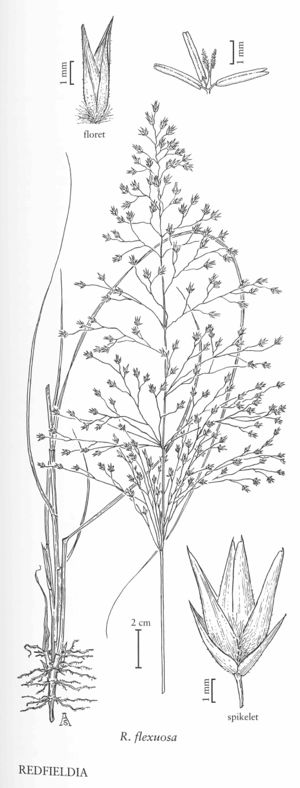Difference between revisions of "Redfieldia flexuosa"
FNA>Volume Importer |
imported>Volume Importer |
||
| (8 intermediate revisions by 2 users not shown) | |||
| Line 4: | Line 4: | ||
|publications= | |publications= | ||
|common_names=Blow out- grass | |common_names=Blow out- grass | ||
| + | |special_status={{Treatment/ID/Special_status | ||
| + | |code=E | ||
| + | |label=Endemic | ||
| + | }} | ||
|basionyms= | |basionyms= | ||
|synonyms= | |synonyms= | ||
| Line 17: | Line 21: | ||
-->{{Treatment/Body | -->{{Treatment/Body | ||
|distribution=Colo.;N.Mex.;Tex.;Utah;Kans.;N.Dak.;Nebr.;Okla.;S.Dak.;Mont.;Ill.;Ariz.;Wyo. | |distribution=Colo.;N.Mex.;Tex.;Utah;Kans.;N.Dak.;Nebr.;Okla.;S.Dak.;Mont.;Ill.;Ariz.;Wyo. | ||
| − | |discussion=<p>Redfieldia flexuosa grows on sandhills and dunes. It is a common and important soil binder in blowout areas. It is only fair livestock forage but, because it grows in areas subject to blowout, this should not be of concern. The only Arizona collection wasmade in 1896; the Washington population was introduced for erosion control.</p> | + | |discussion=<p><i>Redfieldia flexuosa</i> grows on sandhills and dunes. It is a common and important soil binder in blowout areas. It is only fair livestock forage but, because it grows in areas subject to blowout, this should not be of concern. The only Arizona collection wasmade in 1896; the Washington population was introduced for erosion control.</p> |
|tables= | |tables= | ||
|references= | |references= | ||
| Line 26: | Line 30: | ||
-->{{#Taxon: | -->{{#Taxon: | ||
name=Redfieldia flexuosa | name=Redfieldia flexuosa | ||
| − | |||
|authority=(Thurb. ex A. Gray) Vasey | |authority=(Thurb. ex A. Gray) Vasey | ||
|rank=species | |rank=species | ||
| Line 33: | Line 36: | ||
|basionyms= | |basionyms= | ||
|family=Poaceae | |family=Poaceae | ||
| + | |illustrator=Linda A. Vorobik;Andy Sudkamp | ||
| + | |illustration copyright=Utah State University | ||
|distribution=Colo.;N.Mex.;Tex.;Utah;Kans.;N.Dak.;Nebr.;Okla.;S.Dak.;Mont.;Ill.;Ariz.;Wyo. | |distribution=Colo.;N.Mex.;Tex.;Utah;Kans.;N.Dak.;Nebr.;Okla.;S.Dak.;Mont.;Ill.;Ariz.;Wyo. | ||
|reference=None | |reference=None | ||
|publication title= | |publication title= | ||
|publication year= | |publication year= | ||
| − | |special status= | + | |special status=Endemic |
| − | |source xml=https:// | + | |source xml=https://bitbucket.org/aafc-mbb/fna-data-curation/src/200273ad09963decb8fc72550212de541d86569d/coarse_grained_fna_xml/V25/V25_63.xml |
|subfamily=Poaceae subfam. Chloridoideae | |subfamily=Poaceae subfam. Chloridoideae | ||
|tribe=Poaceae tribe Cynodonteae | |tribe=Poaceae tribe Cynodonteae | ||
Latest revision as of 17:58, 11 May 2021
Culms 50-130 cm. Ligules to 1.5 mm; blades 15-45 cm long, 2-8 mm wide. Panicles 20-50 cm long, 8-25 cm wide. Spikelets (3)5-8 mm long, 3-5 mm wide. Lower glumes 3-4 mm; upper glumes 3.5-4.5 mm; callus hairs to 1.5 mm; lemmas 4.5-6 mm, glabrous or shortly pubescent, veins glabrous, entire or with 3 minute teeth; paleas glabrous; anthers 2-3.6 mm, yellow to reddish-purple; lodicules 2, truncate. Caryopses oblong, terete. 2n = 25.
Distribution
Colo., N.Mex., Tex., Utah, Kans., N.Dak., Nebr., Okla., S.Dak., Mont., Ill., Ariz., Wyo.
Discussion
Redfieldia flexuosa grows on sandhills and dunes. It is a common and important soil binder in blowout areas. It is only fair livestock forage but, because it grows in areas subject to blowout, this should not be of concern. The only Arizona collection wasmade in 1896; the Washington population was introduced for erosion control.
Selected References
None.
